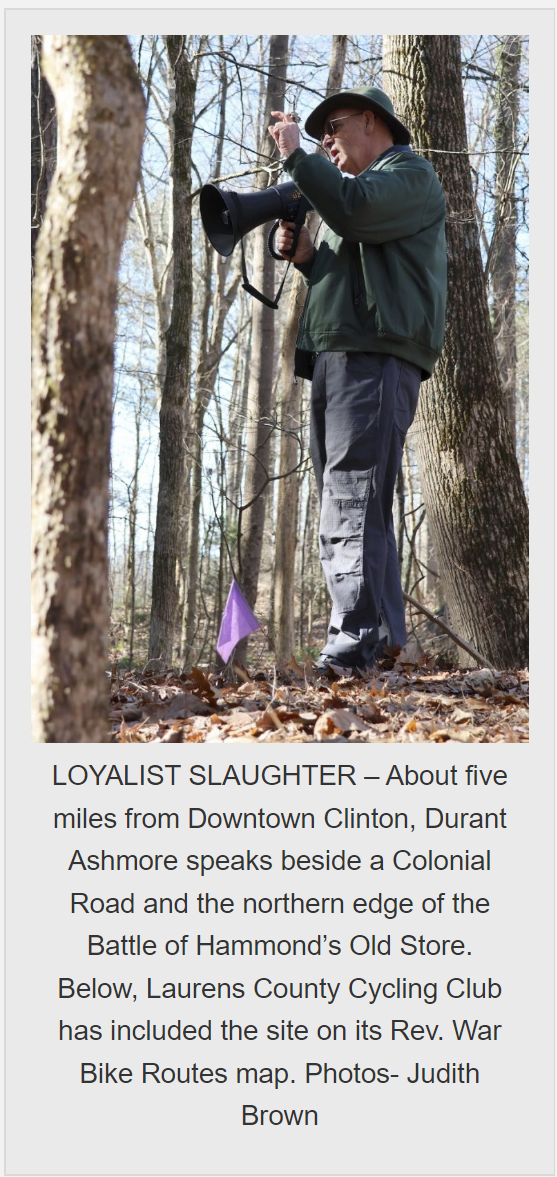Recently discovered Clinton battle site precursor to famed Battle of Cowpens
- Judith Brown
- Feb 6, 2023
- 3 min read
Clinton, South Carolina – In a wooded area near Greenplain Road outside Clinton, about 40 people, including cyclists on a morning ride and history buffs searching for Revolutionary lessons, came together for an outdoor history lesson.

The rural setting is where 150 Loyalist soldiers were either killed or wounded by sabre or musket on Dec. 30, 1780, at the recently discovered battleground site of Hammond’s Old Store about five miles from downtown Clinton. “We don’t know where the store was,” said Revolutionary War Battleground Preservationist Durant Ashmore. “But this site has been fully habitated since that battle, and we are very fortunate this site is as pristine as it is.” Except for the temporary markers put in place for Saturday’s Revolutionary War History Field trip, the battleground and colonial trail near Hammond’s Old Store looks like any other wooded tracts in Laurens County. Through the high technology of lidar imaging and the use of metal detectors, researchers with the South Carolina Battleground Preservation Trust only recently narrowed down the actual battlefield as a 200-by-50-yard area overlooking the edge of Bush River, a stream that starts in downtown Clinton and and winds toward Columbia. Artifacts collected included musket balls, sabre tips, buttons, buckles and other remnants that serve as a testament to the battle.
“South Carolina is leading the way on these battleground discoveries,” Ashmore said. “The team spent five weekends a year ago working to determine what happened, finding artifacts which helped determine the parameters of the battlefield.” Currently the land is private property, but the South Carolina Battleground Preservation Trust hopes to purchase the tract. The Laurens County 250th Committee wants it to be part of a road map of Laurens County battle sites.

There are numerous stories within each battle, Ashmore said. Documents also show that many of those fighting in these battles were neighbors and sometimes relatives. “What happened here at Hammond’s Old Store epitomizes the civil war that occurred here in the backcountry of South Carolina in particular,” Ashmore said. “Many of the men who fought here knew each other.” Revolutionary battle sites are all across South Carolina, and while battles such as Cowpens have been heavily documented, this one at Hammond’s Old Store was almost unknown. It was also pivotal because the losses and successes of battles set off a sort of domino effect, Ashmore said.
“After the disastrous battle of Camden that August,” Ashmore said, “Gen. George Washington sent a supporting Third Continental Army to the South under the command of Nathanael Greene, the namesake of Greenville, and Lt. Col. William Washington, a distant cousin and the premier calvary officer in the Continental Army.” Washington and his 1,000 soldiers, including his highly trained group of 80 mounted calvary officers which used sabers rather than muskets, were sent to the Old Ninety Six District chasing down the group of plundering loyalists.

“All the supporters of the King were loyalists but if they were particularly bad and obnoxious loyalists they were Tories,” Ashmore said. “These were Tories, and they knew they were being chased, but they didn’t understand what danger they were in.” Washington caught up with them at Bush River at Hammond’s Old Store, and when he crested the hill, saw their arms stacked up while they broke for lunch. “He immediately charged. They never fired a shot. He rode through them chopping them down with swords while riflemen on the flanks poured in with rifle fire,” Ashmore said. “It was a slaughter and not a single patriot was killed.” The success of the battle inspired area patriots, and 18 days later, 1,000 volunteer militia showed up to support the Continental soldiers for the highly documented Battle of Cowpens. Only 50 militia showed up in support of the Loyalists.
This story originally ran on page 3 in the Wednesday, Feb. 1 issue of The Laurens County Advertiser.




Comments